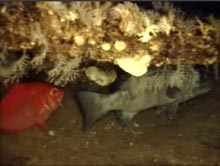
Wreckfish and red bream, two of the largest fish species on the Charleston Bump, share space under a slab of manganese-phosphorite covered with soft corals and anemones. Tape 3414-1 (42:30)
![]() Click image for video (QuickTime, 516 Kb).
Click image for video (QuickTime, 516 Kb).
Investigating the Charleston Bump:
2003 Mission Summary
August 17, 2003
David Wyanski
Fish Biologist
South Carolina Department of Natural Resources
Participation in this cruise has been like putting together an unknown picture puzzle. Many of us have been struck by the newness that each day brings. During sub dives or as we looked at the videotapes from those dives, a sense of discovery occurred repeatedly. New scenes such as these captured our attention for minutes on end:
(1) a vertical profile of rock layers (manganese-phosphorite and foraminifera limestone) that looks like an oreo cookie
(2) invertebrates like basket stars and fly-trap anemones living on the edge of a cliff or overhang
(3)wreckfish Polyprion americanus and red bream Beryx decadactylus, two of the largest fish species on the Charleston Bump, sharing space under a slab of manganese-phosphorite covered with soft corals and anemones. (mp4, 1.6 MB)
The highlight of the cruise was, of course, the 14 dives in the Johnson-Sea-Link II manned submersible. Each successive dive seemed to reveal habitat and fauna heretofore unseen. I especially noted that scientists in the sub were careful to collect rocks and biological specimens not seen during previous dives, which led to a great sense of anticipation each time the sub arrived on deck. We've learned so much more about the Charleston Bump since our previous visit here in September 2001.
In the first three dives over three days, we were just beginning to learn the lay of this underwater mountain that reaches high enough to redirect the Gulf Stream, the dominant surface current in the western North Atlantic Ocean. Under the capable direction of Dr. Charlie Barans (chief scientist) and John McDonough (expedition coordinator in both 2001 and 2003), this cruise allowed us to explore unknown parts of the Bump that are south of the 2001 dive sites.
Though diving in the sub gave investigators a first-hand look at this unknown undersea terrain, equally important were the sampling activities that took place on the research vessel Seward Johnson, the support ship for the submersible. Instruments were deployed to measure temperature, salinity, oxygen content, and current speed and direction throughout the water column. This information is used to describe the water column and the dynamics of water flow at the Charleston Bump and to characterize the habitat of the organisms we collected. The sub and vessel crews also use this data to improve the chances of putting the sub on its target site.
Lastly, we used a neuston plankton net to collect small crustaceans and fishes in surface waters and a pipe dredge to collect organisms in the top few centimeters of sediment on the ocean bottom. On the first two dives, we encountered low-relief habitat, mostly in the form of manganese-phosphorite pavement covered by a thin veneer of sand. Sponges and solitary stony corals were attached to exposed portions of the pavement. It was our intent to place the sub on habitats with higher relief, but the Gulf Stream current carried the sub beyond those targets. The first dives helped the sub and vessel crews fine-tune the launch procedure for the sub in this high-current environment.
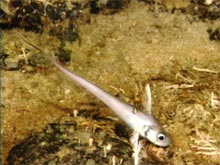
A grenadier or "rattail" hovers near the bottom in a typical head-down posture at a depth of 1,850 ft. Tape 3417-2 (09:10). Click image for larger view.
In subsequent dives, we encountered a greater variety of habitats, including those with high relief. As seen in the Quicktime video clip, the largest bottom-dwelling species of bony fish, wreckfish and red bream, tend to occupy habitats that provide a large amount of protected space (e.g., caves and overhangs). Invertebrate growth (anemones, sponges, soft corals, and hydroids) on these overhangs can be elaborate, even on the underside.
Away from the areas of steepest relief, we noted fauna that were adapted to lower-relief habitats. In areas with manganese-phosphorite rubble or low-relief outcrop interspersed with patches of sand, we noted that smaller fish species were often associated with an invertebrate or rock formation that conferred protection. Moras, a cod-like fish in the genus Laemonema (family Moridae), and rattails (family Macrouridae) were often seen near small overhangs and crevices, or near fan-like sponges. Perhaps the spatial separation between small and large fish species represents habitat partitioning to avoid predation. The tails of these two fish species are small, meaning that they would have trouble avoiding fast-swimming predators.
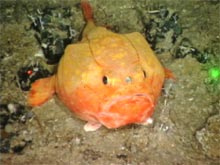
A gaper rests on its pectoral and pelvic fins at a depth of 1,860 ft. Tape 3417-1 (11:38). Click image for larger view.
A most intriguing fish that we observed on several occasions in the same rubble/outcrop habitat was a gaper (Chaunax sp; family Chaunacidae). Gapers are a relative of frogfishes and deep-sea anglerfishes, and, being very sedentary, they usually rest on their pectoral and pelvic fins, moving only to catch prey or to avoid a predator. They are ambush predators and may use the modified first spine of their dorsal fin, which is located between their eyes, as a lure to attract unsuspecting prey. To ward off predators, they expand their bodies by rapidly taking in water. One specimen was captured with the suction sampler on the sub at a depth of more than 1,800 ft, and, to our amazement, it survived the thermal and pressure changes associated with being brought to the surface. It is being held in the quarantine facility of the South Carolina Aquarium, with the hope that it will be added to the deep-sea tank there.
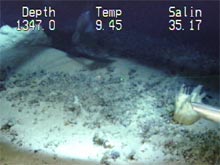
A "chimney" sponge (right) and a fan-like sponge (left) with associated sediment pile collected by the JSL II at 1,347 ft. Tape 3411-2 (09:22). Click image for larger view.
The invertebrates in these low-relief habitats were equally impressive. We saw sponges of many shapes and sizes. The largest specimen was a globe-shaped massive sponge, 30 cm in diameter, with pale rose coloration. Other sponges, to which we gave the name "chimney" sponge, were pale white and had several openings with long extensions. To the left of the chimney sponge (see photo, left), we noted that a fan-like sponge had created a microhabitat on its down-current side (in view) by reducing water current velocity, thereby causing the deposition of sediment.
The pile of sediment was collected with the suction sampler on the sub and will be examined to see if invertebrate abundance is greater in the sediment pile as compared to sediments in adjacent areas with higher currents. There may even be an advantage for the sponge. If the sponge's impediment of water flow creates an eddy (a swirling flow) on the down-current side, that eddy may keep the fine particulate material (organic material, bacteria, and dinoflagellates) on which the sponge feeds in its vicinity for a longer period.
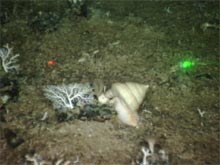
A "slit-shell" snail, the first one we've seen on the Bump, was collected by the JSL II at 1,870 ft depth. Tape 3417-1 (07:18). Click image for larger view.
One final invertebrate of note was a gastropod (snail) called a slit-shell. The origin of its name is obvious. It was the first snail we collected on the Charleston Bump and it may well represent an extension of the species' geographic range.
Thus ends the exciting cruise phase of this project. We've learned so much about the Charleston Bump, yet we've only begun to examine the videotapes from sub dives and the collected samples and data. Many more interesting findings are surely waiting down the road, maybe even new species in our samples. Certainly, many other areas of the Charleston Bump remain to be explored. Next year, perhaps!
























